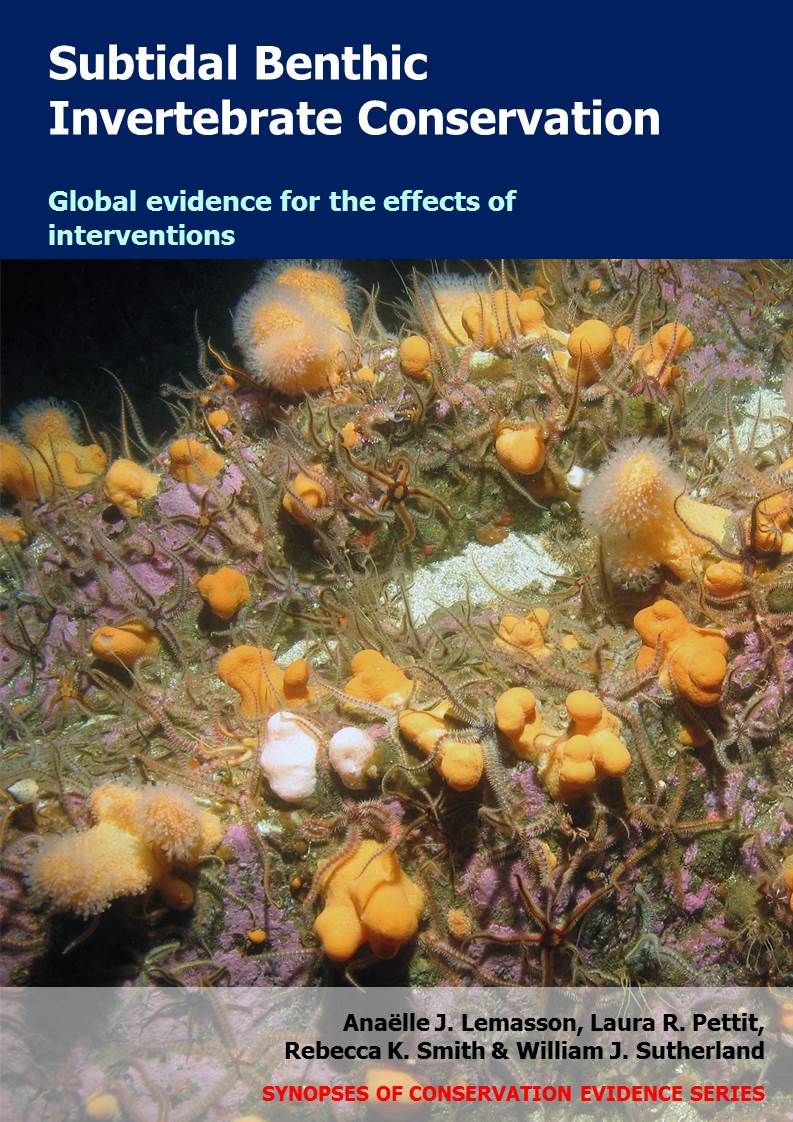Restore biogenic habitats (other methods) - Restore seagrass beds/meadows
-
Overall effectiveness category Unknown effectiveness (limited evidence)
-
Number of studies: 3
View assessment score
Hide assessment score
How is the evidence assessed?
-
Effectiveness
40% -
Certainty
30% -
Harms
0%
Study locations
Supporting evidence from individual studies
A replicated, randomized, controlled, before-and-after study in 1990 of eight estuarine plots in Waquoit Bay, Massachusetts, North Atlantic Ocean, USA (Deegan et al. 2002) found that four months after restoration of common eelgrass Zostera marina beds by removing macroalgae, abundance of mobile invertebrates (decapods) had increased and was higher in restored than unrestored plots, but abundance of sessile invertebrates had not increased. Prior to restoration, all plots had similar abundance of decapods (restored: 24 vs unrestored: 27/m2) and sessile invertebrates (26,000 vs 22,000/m2). After four months, decapod abundance had increased and was higher in restored (82) than unrestored plots (35/m2), while sessile invertebrate abundance had decreased overall and remained similar across plots (restored: 5,000; unrestored: 8,000/m2). Following restoration, macroalgae biomass decreased in all plots (restored: from 96 to 20; unrestored: from 127 to 33 g/m2), and eelgrass abundance increased in all plots and was higher in restored plots (restored: from 3 to 19; unrestored: from 3 to 7 shoots/m2). Two 25 × 25 m experimental areas were selected, each with four 100 m2 plots. In May 1990, eelgrass was restored in one randomly selected area by manually removing macroalgae weekly. A second area was left unrestored. Plots were surveyed in April and monthly in June–September. Sessile invertebrates (>0.5 mm) were sampled in 3 plots/area using two cores (0.073 m2) and counted. Macroalgae were obtained from the cores and dry-weighed. Decapods (> 3 mm) were sampled using one 1 m2 throw net/plot and counted. Eelgrass shoots were counted along one 14 m2 diagonal transect/plot.
Study and other actions testedA replicated, controlled study in 2008 of 12 seagrass sites in Diani Beach, Indian Ocean, south coast of Kenya (Daudi et al. 2013) found that transplanting plastic seagrass mimics into either bare sites, previously-restored seagrass sites, or natural seagrass sites, resulted in different abundance of invertebrates on mimic leaves between sites after 21 days, but similar diversity of invertebrates on mimic leaves, and similar diversity and abundance of invertebrates in the surrounding sediment (values not reported). Abundance on mimic leaves was higher on the natural (39 individuals/100 cm2) and bare (49) sites, compared to the previously-restored sites (12), but remained lower on all mimic leaves compared to natural seagrass leaves (83). However, species richness on all mimic leaves (10) appeared similar to that of natural seagrass leaves (11) (not statistically tested). Invertebrate abundances in the sediment were not reported. There were nine sites (0.7 m depth): three bare (no natural seagrass), three previously-restored (one year previously by transplanting natural seagrass, but damaged overwinter), and three natural seagrass sites. Three plastic seagrass mimics (cluster of four plants) were transplanted to each site in August 2008. After 21 days, invertebrates (38 µm–1 mm in size) living on the leaves and in the sediment around each mimic were identified and counted (see paper for details). Three natural seagrass sites without transplanted mimics were sampled for comparison.
Study and other actions testedA replicated, randomized, controlled study in 2010–2011 of 18 seagrass restoration sites in Cutter Bank, Florida Keys, USA (Bourque & Fouraurean 2014) found that one year after restoration, Thalassia testudinum seagrass beds developed a different invertebrate community composition compared to unrestored sites, but not similar to that of natural sites, and similar species richness and abundance to unrestored and natural sites. Restoring by fertilizing had no effect on the invertebrate community but adding sand led to communities different from both unrestored and natural sites (community data presented as graphical analyses and statistical model results). After a year, species richness was similar across sites (restored: 8.6; unrestored: 7.5; natural: 10.2 species). Invertebrate abundance was not different at sites restored by adding sand (abundance: 43.6 individuals/sample) compared to both unrestored (35.7) and natural sites (38.6), with no effect of fertilizing (data not shown). Abundance at the natural sites had declined throughout the year (from 92.2 to 38.6). Seagrass cover declined at all sites throughout the year. Seagrass restoration was undertaken in 2010 at 12 sites disturbed by vessels and six undisturbed natural sites. Three disturbed sites were left unrestored, three were restored by fertilizing, three by adding sand, and three by both fertilizing and adding sand. Of the six undisturbed natural sites, three were fertilized, and three were left natural. Restoration option was randomly allocated to disturbed and undisturbed sites. Zero, three, six and 12 months after restoration, three sediment samples were collected at each site using a randomly placed hand corer (7.3 × 10 cm). Invertebrates (>0.5 mm) were identified and counted.
Study and other actions tested
Where has this evidence come from?
List of journals searched by synopsis
All the journals searched for all synopses
This Action forms part of the Action Synopsis:
Subtidal Benthic Invertebrate Conservation





)_2023.JPG)














